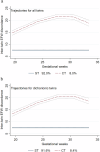Impact of inter-twin growth discordance on preeclampsia: based on ultrasonic estimated fetal weight
- PMID: 39627393
- PMCID: PMC11879843
- DOI: 10.1038/s41440-024-02027-5
Impact of inter-twin growth discordance on preeclampsia: based on ultrasonic estimated fetal weight
Abstract
A retrospective cohort study with 4396 twins who registered before 13 gestational weeks and delivered between January 2013 and December 2020 at Shanghai First Maternity and Infant Hospital, China, was conducted to clarify causal associations between inter-twin estimated fetal weight discordance and preeclampsia. Ultrasound measurements of fetal biometry were collected until the confirmation of preeclampsia diagnosis or the termination of pregnancy (when preeclampsia did not occur). Inter-twin discordance was divided into binary variables using cut-offs of 10%, 15%, and 20%. The associations between inter-twin discordance and preeclampsia were analyzed using generalized estimating equations and group-based trajectory modeling methods. The incidence of preeclampsia was 13.9%, among which 21.8% of cases were diagnosed at early onset and 55.3% at a severe stage. Inter-twin discordance based on estimated fetal weight during pregnancy was positively associated with preeclampsia. The associations were robust and constant by treating the discordance as continuous and binary. Two groups, the stable trajectory group, including 92% of participants, and the changing trajectory group, including 8% of participants, were divided according to the group-based trajectory models. Compared with the stable trajectory group, the risk of developing preeclampsia in the changing trajectory group increased by 50.3% (OR = 1.502, 95%CI: 1.073, 2.105). Subgroup analysis showed positive association primarily in early-onset preeclampsia (OR: 3.859, CI: 2.293, 6.494) and severe preeclampsia (OR: 1.896, CI: 1.264, 2.844) subgroups. These findings can provide a direction to reduce the incidence of preeclampsia in twin pregnancies, considering growth discordance as a high-risk factor in clinical practice.
Keywords: Generalized estimating equations (GEE); Group-based trajectory model (GBTM); Growth discordance; Preeclampsia; Twins.
© 2024. The Author(s).
Conflict of interest statement
Compliance with ethical standards. Conflict of interest: The authors declare no competing interests.
Figures


Comment in
-
Inter-twin growth discordance in monochorionic twins as a novel risk factor for preeclampsia.Hypertens Res. 2025 Mar;48(3):1024-1026. doi: 10.1038/s41440-024-02047-1. Epub 2024 Dec 5. Hypertens Res. 2025. PMID: 39639134 No abstract available.
References
-
- Francisco C, Gamito M, Reddy M, Rolnik DL. Screening for preeclampsia in twin pregnancies. Best Pr Res Cl Ob. 2022;84:55–65. - PubMed
-
- Rolnik DL, Nicolaides KH, Poon LC. Prevention of preeclampsia with aspirin. Am J Obstet Gynecol. 2022;226:S1108–19. - PubMed
-
- Giorgione V, Melchiorre K, O’Driscoll J, Khalil A, Sharma R, Thilaganathan B. Maternal echocardiographic changes in twin pregnancies with and without pre-eclampsia. Ultrasound Obst Gyn. 2022;59:619–26. - PubMed
MeSH terms
LinkOut - more resources
Full Text Sources
Medical

